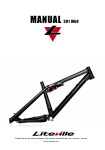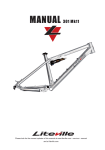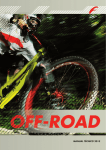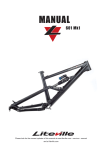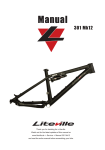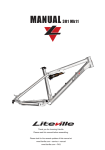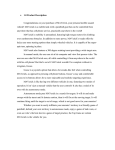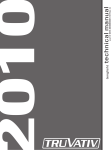Download MANUAL 301 Mk8
Transcript
MANUAL 301 Mk8 Please look for the newest updates of this manual at www.liteville.com > service > manual and at liteville.com Limits for the Liteville 301 Frame Please be aware, not all parts available on the market can be used on the Liteville 301 frame and some parts simply should not be used! The following parts have limits: Fork Only forks with a maximum built height of 565 mm are permitted for use. Crank/Bottom Bracket Not all available crank/bottom bracket units can be used. The bottom bracket shell width is 73mm. Look for clearance Make sure the left crank does not collide with the left chain stay. Since the Liteville 301 frame is only suitable for Shimano EType front derailleurs you need a bottom bracket that can be used with one. Seatpost The Liteville 301 frame needs a seatpost with a diameter of 34.9 mm. To prevent frame damage, the seatpost needs to be inserted down to the mark on the seat tube. Frames with Works Finish do not have a laser etching. Nevertheless, you need to adhere to the minimum inserting depth (120 / 140mm, see picture on left). Note that the minimum insertion depth is dependent on length of the seatpost length above the seat tube (below or above 200mm). Simply stated: if the seat post is pulled out more than 200mm (upper edge of seat tube to seat rails) only the lower laser etching is valid! 2 Tires The Liteville 301 frame is compatible with tires up to 2.5“. Frames size S and XS have limited clearance due to shorter chain stays. Seat clamp In case you do not want to use the original Syntace clamp you need a clamp with a diameter of 38mm due to the oversize build of the seat tube. Watch for enough clearance of the rear triangle during compression. To test, deflate shock completely and carefully compress the rear entirely. Shifter cable For a trouble-free installation use cable housing with a 4 mm outside diameter, for example Shimano SISSP41. Rear shock / Shock mounts Do not use shocks with an installation length other than 190 mm. Shock stroke can not exceed 50 mm. Tip: The Liteville 301 frame has a special low-ratio suspension design and does not work well with every shock available. Our shocks have been specifically tuned for our frames. Hint: A slight brush of the rear wheel at full compression is nothing to worry about. It will damage nothing and may only leave a brush mark on the seat tube. Brakes The Liteville 301 frame has been designed for exclusive use of disc brakes. The maximum diameter of the rear disc rotor is 210 mm. Installation Frame preparation The contact surfaces for bearings and brakes etc. have already been prepped at the factory – you do not need to surface anything to install headset, bottom bracket or brakes. Headset / fork The headset bearings have been pressed into the frame by the factory. In case you need to change bearings, do not forget to use grease and make sure the bearings are pressed in evenly and completely. It is best to use a special tool for the task. Fork installation First, install both seals (grey lip on the outside, black o-ring on the inside) on the cover of the SuperSpin headset. Install the larger of the two slotted rings (the base plate, see picture) onto the steerer tube. Insert the steerer tube into the head tube, add the smaller slotted ring onto the steerer tube and install the black cover plate. Make sure the fork does not collide with the frame when turning. 3 Now slide the lower (depending on fork, either the tapered or the 1 1/8” one) of the two slotted bearing cones onto the steerer tube. If using a 1 1/8” fork you now need to install the lower 1 1/8” reducer in the lower bearing (do not forget to grease). Insert fork into the frame, slide upper 1 1/8” cone onto steerer tube and install the cover plate. SuperSpin tapered, lower 1.5, upper 1 1/8 SuperSpin 1 1/8 with reducer for 11/8 steerer tubes Tip 1: Before installing the cover plate, grease bearing heavily. It will keep moisture away and aids easy spinning. Tip 2: Pull the headset tight with the adjustment bolt, then loosen the bolt again. Only now adjust bearing play. With that procedure you can make sure that the bearings have been seated correctly and will spin easily. Make sure the fork does not hit the down tube when spinning the bar. Bar / Stem Install bar and stem according to manufacturer’s instructions onto the steerer tube. Hint: test ride first with uncut steerer tube. You would not be the first person to be ticked off because you cut the steerer tube too short! Shift levers Install levers according to manufacturer’s specifications. Bottom bracket / crank & front derailleur Liberally grease contact surfaces for the bottom bracket. Fix the E-Type derailleur with the bolt (supplied by Shimano). Important: Do not use a spacer between BB and derailleur. Now install both BB bearing cups according to installation instructions. Use enough grease! From experience we know that especially outboard bearings tend to creak if not enough grease has been applied to the contact surfaces. 4 Now tighten the 5 mm Allen screw of the derailleur according to manufacturers specifications and install crankset. Make sure there is enough room for rotation between crank arms and frame – test for enough clearance. Installing cables on the bottom tube Below the cable clamps you will find pre-installed pads. They are not glued! We recommend affixing them while installing shifter cables and brake lines. To do, degrease the frame in the area of installation. Remove aluminium bolt, cable clamp and pad, and then remove brown backing of pads. Stick the pads to the frame as you see in the picture, above the threading. Now you can mount the rear shifter cable and the rear brake line on top of the pads to achieve an optimal routing. Make sure the front, “half”, cable clamps face inwards with their tongues. Installation of HammerSchmidt Remove the main-pivot bolt plus the cover plate on the right side and replace it by the HammerSchmidt titanium bolt from the optional HammerSchmidt kit. Add the included HammerSchmidt adapter (with a little grease) to the ISCG mount and install the HammerSchmidt crank according to specs. Hint: The included HammerSchmidt adapter is specific to every individual frame. It cannot be swapped with another frame. 5 Cable routing for HammerSchmidt To install cabling for HammerSchmidt, you need to exchange 3 clamps on the bottom tube. First, replace the single clamp through a double clamp from further down. The shifter cable for the HammerSchmidt crank will be routed in parallel to the rear shifter cable on the outside. Replace the two first clamps installed to the bottom tube by the triple clamps from the HammerSchmidt kit. Behind the last triple clamp the shifter cable will go directly into the HammerSchmidt crank housing. Cable routing with installed bottle cage • Either route cable in the area of bottle cage with small plastic clamps. •O r use shrink tube (preferably thick walled stuff like Hellermann Tyton) to route in parallel to shifter cable Without bottle cage • Install an additional Liteville “HammerSchmidt cable clamp” onto the second bottle cage inser •U se shrink tubing as described above Cable routing for front derailleur (without HammerSchmidt) Before you can install the cable housing, you need to unbolt the front shock mount and fold down the shock. To mount the cable housing, you will find special mounts on the bottom side of the top tube. Proceed as follows: Sharply bend a zip tie about 10 – 15 mm behind the tip so get something close to 6 a hook. Now insert the hooked zip tie into the cable mount. Make sure you insert only far enough so the tip snaps over the little cross ridge. By pulling and pushing, you can direct the zip tie all the way through until the head is at the top tube. Now you can install the cable housing (and the optional cable housing for an adjustable seat post. Note: only pull the zip tie tight by hand! Cut the zip tie right at the head and turn the heads all the way to the top tube so they do not stick out. The shifter cable is running between top tube and shock. Let the shifter cable run through left rear shock mount and seat tube. The shifter housing for the E-type derailleur should neither run in a large arch nor in a very “direct” way to ensure good function. 7 Cable routing for the rear derailleur The shifter cable for the rear derailleur is being routed directly through the seat tube into the chain stay. To protect the cable even better from corrosion, we use an additional, flexible tube. Hint: Do not remove the transparent plastic tube. In case you did remove it, reinstall it by pushing it thoroughly into its seat (blue in the picture) and do NOT use lubrication. The exit for the shifter cable is at the lower end of the right chain stay. Changing a shifter cable housing • Leave the transparent tube in place •C ut the new cable housing in a skewed fashion • Spray a little silicone spray into the guide tube • Insert shifter cable from the front until it is at the chain stay yoke • Use the rest of the cable housing as a handle by rolling it up. Let the housing find its way by turning and pushing at the same time. It will work even easier if the rear triangle will be moved up and down by about 1 – 2cm (remove shock mount). 8 •P ush further until the housing hits the Horst link and let it find its way though the hole by turning and pushing •N ow cut the ends of the housing as usual. Done! Routing of brake line The brake lines and shifter cables are being routed continuously. Please to not over-tighten the bolts of the clamps to avoid crimping. If crimped, shifting and braking lines will lose function. Be aware that the brake line will be shortened during compression. Leave it long enough! Use the included clips for mounting the brake line on the left chain stay. If you use zip ties, squeaking noises may occur. Be aware: The routing pictured is for brake callipers where you can turn the line towards the rear. It will vary with other brake models. Rear derailleurs from Shimano: All derailleurs starting from model year 2009 will work (only Shadow!). Installation of old derailleurs (with the large diameter housing bend) is not recommended on Liteville 301 frames from Mk8 on because they do not harmonize well with the new, low-profile routing. 9 Rear derailleurs from SRAM: SRAM X.7, X.9 and X.0 will fit - as well as all older SRAM rear derailleurs. Reasons for preference of newer Shimano and SRAM derailleurs: •D irect cable routing without unnecessary arcs •B etter protection against branches •R educed friction by avoiding large radii •N o crashing of derailleur against chain stay •R educed noise Install and adjust the derailleur according to the manufacturer’s specifications. Attention: For perfect protection, install the optional Syntace RockGuard II. There are different models for SRAM, Shimano Shadow and Saint models. Tip: There is a sticker included for the front derailleur. Install it as pictured to reduce chain slap at the front derailleur. Saddle, seat post and seat tube Check the seat tube for edges and burrs. Remove them with fine sanding paper before inserting the seat post. Attention: If fully inserted, the seat post may reach the “dent” for the E-type front derailleur. If you try to force it any deeper, you may damage seat post and/or frame. Attention: Observe the “minimum insert” mark at the seat tube as described in the chapter about limits. Install saddle according to manufacturers specifications. Tip: Cut the seat post to the “minimum insert” dimension after being sure that it works well. That way you can lower the seat post to the max. 10 Setup Adjustment of sag For optimal performance, it is advisable to adjust the Liteville 301 precisely. Do it the following way: • • Ride your Liteville 301 with full equipment (backpack, helmet etc.) •L ook down onto the sag indicator “Dynamic Level” and check the position of the two indicator pins.. Attention: Especially at night, one is tempted to reach down and feel the sag instead of looking down. We strongly discourage you from doing so; you may severely crush your fingers! • If the two pins do not point at each other, adjust air volume in the shock. Either add or remove air. •O ur recommendation is pin-to-pin. • You can see adjustment possibilities in the following picture. Dynamic Level adjustments: Soft: Max. pin above frame pin Our recommendation: pin-to-pin Hard: Max. pin below frame pin Note: A small backpack may raise the weight on the rear axle enough to make an air volume adjustment necessary. Adjustment of rebound: •R ide at medium speed off a curb. The chassis should only bounce once. • If the rebound is too fast (chassis bounces more than once), close the rebound circuit a bit. Please be aware: the rear end should not rebound too slowly either or else the suspension will “pack up” after riding over several obstacles in quick succession. Please observe installation instructions and manual from the manufacturer of the shock. 11 Build-in interfaces Adjustable seatpost with remote The Liteville 301 Mk8 is ready for installation of an adjustable seatpost with remote actuation. Optimum function is only guaranteed for posts where the cable is mounted at the seat clamp area and not at the head. Use only cable housing with an diameter of 4mm (for example Shimano SIS-SP41). Syntace SCS Chain Guide Integrated connections for the patented Syntace SCS chain guide are standard at the Liteville 301 Mk8. The future Syntace SCS chain guide offers low weight and an unknown precision coupled with reliability for single, double and triple cranks. Maintenance and care Bearings All bearings used are greased for life and do not need to be disassembled to be repacked with grease. In case of a defective bearing you can order a new bearing from your dealer or from Liteville. Headset In case you need to change the headset you can order a new one through your dealer or from directly Liteville. 12 Bolts All frame bolts used are high-tensile strength titanium bolts. They have been manufactured especially for our Liteville frames. In case of loss or damage you can order them through your dealer or from Liteville. On all frame bolts a thread lock has been applied, so make sure you heat them with a hot air gun if you want to disassemble them. Use a thread lock (like Syntace Bond 48) when reinstalling! From time to time make sure all bolts are still tightened– torque values can be found laser-etched onto the frame on black anodized frames. You will also find torque values in the rear of this manual. Hint: Sometimes one needs to do the opposite of what one expects…for example, if it creaks up front, grease in the rear. The suspected creaking from the bottom bracket might not be caused there at all. Leave the BB alone and try this first: •R emove cassette •A pply copper paste thoroughly to rotor surface •A fter re-installing cassette tighten with full torque Surface Never use a high-pressure washer to clean your frame! The high water pressure will force water into the bearings and premature corrosion and wear will follow. Dirt, blown away by high water pressure, will scratch the surface and mar it permanently. To clean your frame, first use water from a hose and then a soft sponge with warm water, preferably with a few drops of dishwashing detergent. Dry frame with a soft cloth. To achieve a nice sheen, use silicone spray and wipe with a soft cloth. Important: make sure the silicone spray does not reach your brakes or rotors. Almost complete loss of braking power will be the result if silicon contaminates brakes. In case brakes are contaminated, clean rotors with brake cleaner and install new brake pads! In addition to the available surfaces race black anodized and your custom color in powder coat, we offer in every production run a limited edition of Works Finish frames. The new Liteville Works Finish is a genuine raw aluminium surface, no imitation. You can see the irregular marks of the manual work. Changes of surface color and stains are standard with this finish. Over time it develops the charm of natural patina on the Works Finish frame. The surface can be re-worked anytime with Scotch-Brite or can be coated. You will find two Scotch-Brite pads included with every Works Finish frame. Please try their effectiveness in an area not immediately visible to make sure you will like it. Logos on Works Finish: You will find two logos cut from 3M material with the frame. If you stick them onto the frame analoguous to the anodized frame or in a different fashion – it is yours to decide! 13 Maximum torque: 15 Nm 10 Nm 1 Nm 10 Nm 110-20 Nm without thread lock Tight bolts only very smooth 15 Nm 6 Nm 6 Nm blue: medium duty thread lock 6 Nm 10 Nm 6 Nm 10 Nm Travel identification: You can see the lever travel also on the basis of the „Dynamic Level“ Sag-Indicators position: 120 mm Lever 140 mm Lever 160 mm Lever 14 green: heavy duty thread lock Notes: 15 Syntace GmbH Am Mühlbach 5C D - 87487 Wiggensbach Tel. +49 (0)8370 929988 Fax +49 (0)8370 929888 [email protected] Sales for Germany, Austria and Switzerland: Syntace GmbH Dammweg 1 D - 83342 Tacherting Tel. +49 (0)8634 66666 Fax +49 (0)8634 6365 Current: 20.09.2010 16 [email protected]
















